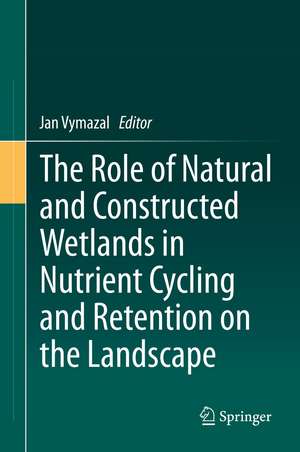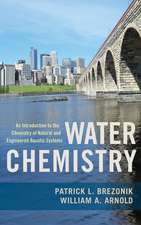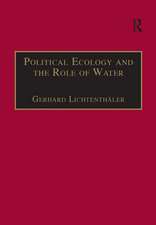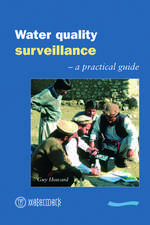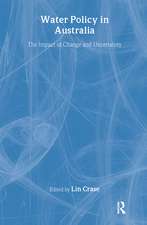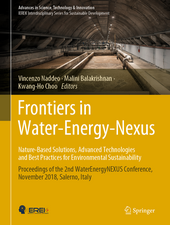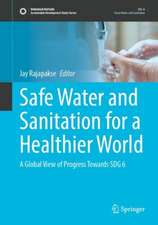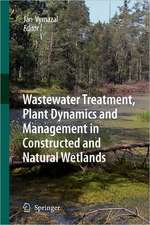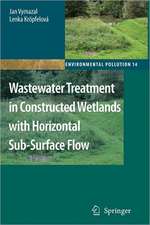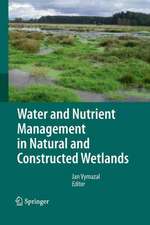The Role of Natural and Constructed Wetlands in Nutrient Cycling and Retention on the Landscape
Editat de Jan Vymazalen Limba Engleză Hardback – 14 oct 2014
| Toate formatele și edițiile | Preț | Express |
|---|---|---|
| Paperback (1) | 642.68 lei 6-8 săpt. | |
| Springer International Publishing – 23 aug 2016 | 642.68 lei 6-8 săpt. | |
| Hardback (1) | 649.06 lei 6-8 săpt. | |
| Springer International Publishing – 14 oct 2014 | 649.06 lei 6-8 săpt. |
Preț: 649.06 lei
Preț vechi: 763.60 lei
-15% Nou
Puncte Express: 974
Preț estimativ în valută:
124.24€ • 134.99$ • 104.43£
124.24€ • 134.99$ • 104.43£
Carte tipărită la comandă
Livrare economică 21 aprilie-05 mai
Preluare comenzi: 021 569.72.76
Specificații
ISBN-13: 9783319081762
ISBN-10: 3319081764
Pagini: 326
Ilustrații: XVI, 326 p. 109 illus., 41 illus. in color.
Dimensiuni: 155 x 235 x 20 mm
Greutate: 0.66 kg
Ediția:2015
Editura: Springer International Publishing
Colecția Springer
Locul publicării:Cham, Switzerland
ISBN-10: 3319081764
Pagini: 326
Ilustrații: XVI, 326 p. 109 illus., 41 illus. in color.
Dimensiuni: 155 x 235 x 20 mm
Greutate: 0.66 kg
Ediția:2015
Editura: Springer International Publishing
Colecția Springer
Locul publicării:Cham, Switzerland
Public țintă
GraduateCuprins
1. Biomass Production in Permanent Wet Grasslands Dominated with Phalaris arundinacea: Case Study of the Třeboň Basin Biosphere Reserve, Czech Republic.- 2. Greenhouse Gas Fluxes from Restored Agricultural Wetlands and Natural Wetlands, Northwestern Indiana.- 3. Assessment of Immobilisation and Biological Availability of Iron Phosphate Nanoparticle-Treated Metals in Wetland Sediments.- 4. Spatial Variability in Sedimentation, Carbon Sequestration and Nutrient Accumulation in an Alluvial Floodplain Forest.- 5. Natural and Restored Wetland Buffers in Reducing Sediment and Nutrient Export from Forested Catchments – Finnish Experiences.- 6. Do Reflectance Spectra of Different Plant Stands in Wetland Indicate Species Properties?.- 7. Global Boundary Lines of N2O and CH4 Emission in Peatlands.- 8. Distribution of Solar Energy in Agriculture Landscape – Comparison Between Wet Meadow and Crops.- 9. Surface Temperature, Wetness and Vegetation Dynamic in Agriculture Landscape – Comparison of Cadasters with Different Types of Wetlands.- 10. Agricultural Runoff in Norway - the Problem, the Regulations and the Role of Wetlands.- 11. Subsurface Flow Constructed Wetlands Models: Review and Prospects.- 12. Behaviour of a 2-Stage Vertical Flow Constructed Wetland with Hydraulic Peak Loads.- 13. A New Concept of Multi-Stage Treatment Wetland for Winery Wastewater Treatment: Long-Term Evaluation of Performances.- 14. Polishing of Real Electroplating Wastewater in Microcosm Fill-and-Drain Constructed Wetlands.- 15. Relationship Between Filtering Material and Nitrification in Constructed Wetlands Treating Raw Wastewater.- 16. Single Family Treatment Wetlands Progress in Poland.- 17. Treatment Wetland for Overflow Stormwater Treatment – the Impact of Pollutant Particles Size.- 18. Treatment Wetlands in Rural Areas of Poland for Baltic Sea Protection.- 19. Long Term Performance of Constructed Wetlands with Chemical Dosing forPhosphorus Removal.- 20. Use of the Macrophyte Cyperus papyrus in Wastewater Treatment.- 21. Does the Presence of Weedy Species Affect the Treatment Efficiency in Constructed Wetlands with Horizontal Subsurface Flow?.
Notă biografică
Jan Vymazal received his degrees (M.Sc. and Ph.D.) from Prague Institute of Chemical Technology. After five years in Water Research Institute in Prague he spent two years at Duke University, North Carolina. At present, he is affiliated with Czech University of Life Sciences Prague where he has become Full Professor at the Department of Applied Ecology. His principal research interests are in the areas of wastewater treatment in constructed wetlands and ecology of natural wetlands. He has published over 400 technical publications including two authored and seven edited books.
Textul de pe ultima copertă
Natural and constructed wetlands play a very important role on the landscape and their ecological services are highly valuable. In fact, some wetland types are regarded as one of the most valuable ecosystems on the Earth. Water management, including flood water retention, biomass production, carbon sequestration, wastewater treatment and biodiversity sources, are among the most important ecological services of wetlands. The book is aimed at the use of constructed wetlands for wastewater treatment and for the evaluation of various ecosystem services of natural wetlands. Special attention is paid to the role and potential use of wetlands on the agricultural landscape. The book presents up-to-date results of ongoing research and the content of the book could be used by wetland scientists, researchers, engineers, designers, regulators, decision-makers, universities teachers, landscape engineers and landscape planners as well as by water authorities, water regulatory offices or wastewater treatment research institutions.
Caracteristici
Provides information about the intensification of constructed wetland treatment efficiency Describes the use of wetlands on agricultural landscape Includes new applications of constructed wetlands
